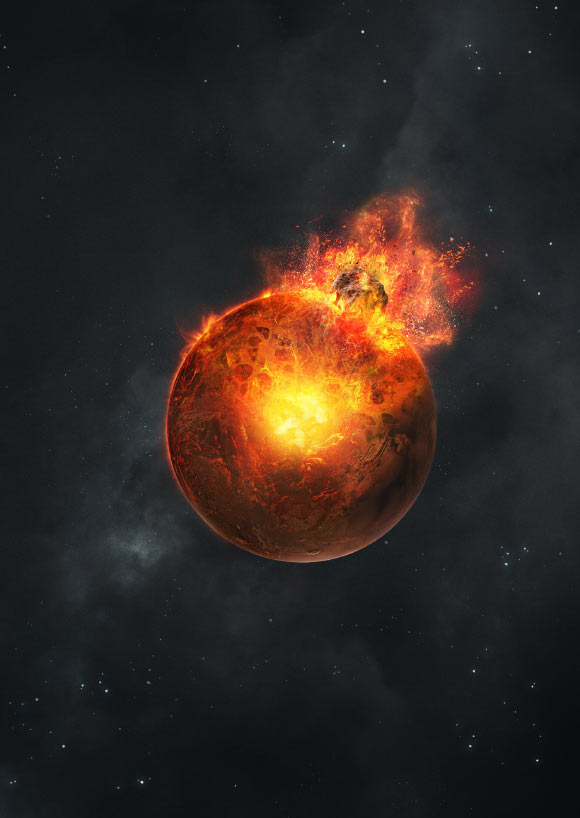Martian Mantle Holds Frozen Record of Planet’s Violent Beginnings, Study Suggests

The mantle of Mars contains ancient fragments up to 4 km wide from its formation — preserved like geological fossils from the planet’s violent early history, according to an analysis of seismic data collected by NASA’s InSight mission.

A giant collision in the early history of Mars created a global magma ocean. Image credit: Vadim Sadovski / Imperial College London.
A planet’s mantle — the vast layer that lies sandwiched between its crust and core — preserves crucial evidence about planetary origin and evolution.
Unlike Earth, where active plate tectonics continually stirs the mantle, Mars is a smaller planet with a single-plate surface.
As such, the Martian mantle undergoes far less mixing, meaning it may preserve a record of the planet’s early internal history, which could offer valuable insights into how rocky worlds form and evolve.
Using data from NASA’s InSight lander, Dr. Constantinos Charalambous from Imperial College London and his colleagues studied the seismic signatures of marsquakes to better constrain the nature of Mars’ mantle.
By analyzing eight well-recorded marsquakes, including those triggered by meteorite impacts, they discovered that high-frequency P-wave arrivals were systematically delayed as they traversed the deeper portions of the mantle.
According to the authors, these delays reveal subtle, kilometer-scale compositional variations within the planet’s mantle.
Because Mars lacks plate tectonics and large-scale recycling, these small-scale irregularities must instead be remnants of its earliest history.
The scaling of Mars’ mantle heterogeneity suggests an origin in highly energetic and disruptive processes, including massive impacts early in the planet’s history, which fractured the planet’s interior, mixing both foreign and crustal materials into the mantle at a planetary scale.
Moreover, the crystallization of vast magma oceans generated in the aftermath likely introduced additional variations
Instead of being erased, these features became frozen in place as Mars’ crust cooled and mantle convection stalled.
“The seismic signals showed clear signs of interference as they traveled through Mars’ deep interior,” Dr. Charalambous said.
“That’s consistent with a mantle full of structures of different compositional origins — leftovers from Mars’ early days.”
“What happened on Mars is that, after those early events, the surface solidified into a stagnant lid.”
“It sealed off the mantle beneath, locking in those ancient chaotic features — like a planetary time capsule.”
“What we are seeing is a ’fractal’ distribution, which happens when the energy from a cataclysmic collision overwhelms the strength of an object,” said Imperial College London’s Professor Tom Pike.
“You see the same effect when a glass falls onto a tiled floor as when a meteorite collides with a planet: it breaks into a few big shards and a large number of smaller pieces.”
“It’s remarkable that we can still detect this distribution today.”
“InSight’s data continue to reshape how we think about the formation of rocky planets, and Mars in particular,” said Dr. Mark Panning, a researcher at NASA’s Jet Propulsion Laboratory.
“It’s exciting to see scientists making new discoveries with the quakes we detected!”
The team’s paper was published today in the journal Science.
_____
Constantinos Charalambous et al. 2025. Seismic evidence for a highly heterogeneous Martian mantle. Science 389 (6763): 899-903; doi: 10.1126/science.adk4292




